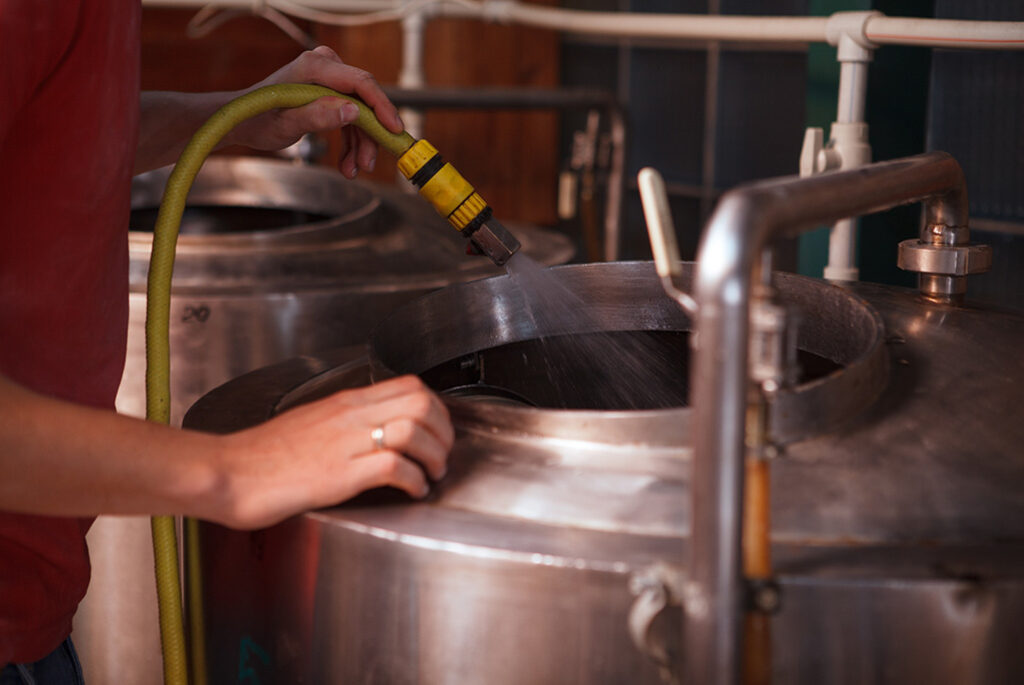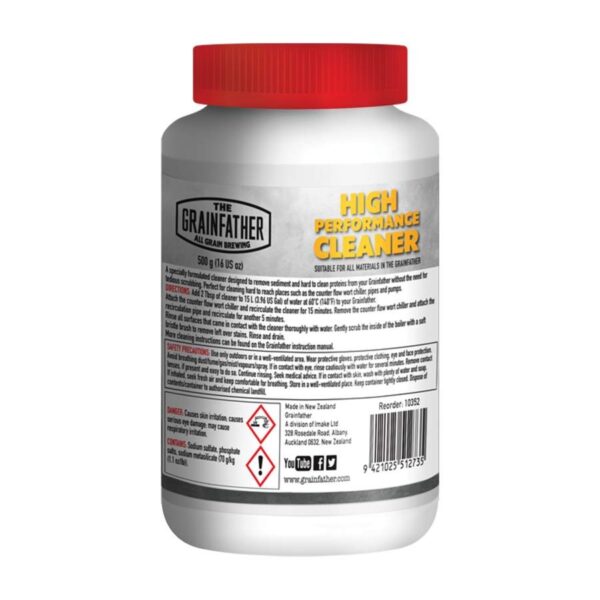You probably know that clean equipment is the first step to making a great beer, but did you know that scrubbing with hot soapy water probably isn’t enough to stop bacteria from ruining an entire batch?
This guide will walk you through the essential steps to effectively sanitise your brewing equipment before you start crafting your brew.
And yes, you have to sanitise everything – even the bottle caps!
If you’ve seen a recipe that asks you to sterilise your equipment, and you’re wondering if that’s the same thing – check out our post on sterilisation vs sanitisation for brewing.
What You’ll Need:
Alkaline cleaner
Washing up liquid is not recommended for brewing – it contains a perfumed degreaser, so it’s no use against mineral scale and protein build-up.
We don’t recommend bleach as it’s a very strong chemical that requires a lot of rinsing. Instead, choose an Alkaline Cleaner designed for brewing.
We recommend using Suresan or Chemsan for routine cleaning and sanitising equipment before use. For deep cleaning or deeper sterilising have a product such as Grainfather High Performance Cleaner, Steri Cleen, or VWP to hand.
Sodium Metabilsulphite used to be the go-to sanitiser for home brewers. However, it gives off sulphur dioxide which can be an irritant to some people and should not be inhaled. Modern sanitisers are more effective than Sodium Metabisulphite and do not create health issues if used correctly.
Scrubbing sponges & rubber gloves
You’ll need good sponges, a clean cloth or towel and PPE gloves are useful to protect your skin.
Contact sanitisers
Many of the sanitisers available to home brewers are “contact sanitisers”. This means that as soon as the sanitiser touches the surface it is clean. It needs to be washed away with clean water after use.
It’s useful to have a dedicated sponge and a household spray bottle filled with sanitiser to hand. You can spray sanitiser directly into taps and syphon systems to ensure effective cleanliness is achieved before syphoning/transferring beer or wine.
No-rinse sanitiser
A no-rinse sanitiser, as the name suggests, allows you to skip the rinsing step. They break down into harmless chemicals that won’t affect your brew soon after use.
You can apply them through sprayers too – Just remember that you need to make the solution up fresh as after 1 hour it will be ineffective.
Choosing your Sanitiser
There are a lot of great sanitisers on the market, but do your research if you’re using any non-stick equipment as some are not safe to use on Teflon or soft metals like copper.
If you want to make life easier then choose Harris SureSan No Rinse Sanitiser as a general-use product as it is kind to metals and removes the need for the rinse step and saves water. Suresan will not mark your clothes if you accidentally spill it either.
If you’ve inherited equipment that’s not been used for a while, or you’ve got heavy soiling, we recommend a heavy-duty solution such as Stericlean. This can be mixed with a biological washing detergent if necessary and equipment soaked in the solution for 24 hours to remove deep-seated stains. Just remember to rinse out the equipment well with tap water after use and be careful as these powerful steriliser cleaners will bleach colour out of clothes.
Clean Water
It seems obvious, but using clean water to scrub and sanitise your equipment is a must. If you’ve got a lot of equipment to wash, change the water as it gets dirtier.
Spray Bottle
To apply the sanitising solution effectively, grab yourself a spray bottle from your local gardening store. Make sure you label it “for brewing use only”. They’re great for spraying inside taps and airlocks (Remember – The golden rule is that everything that your wine or beer touches should be sanitised immediately beforehand).
For the ultimate cleaning and sanitising accessory choose the Rapid Rinse Cleaning and Sanitising System.
It comes with a range of tools to sanitise any equipment but it’s best feature is that it contains a spray lance and a spray brush for cleaning fermenters and kegs, and even has an adaptor for pumping sanitiser directly through commercial-style beer taps and faucets.
You can even buy an adaptor for the Rapid Rinse to spray sanitiser directly through the dip tube and disconnect the valve of a Corny Keg, eliminating the need to keep dismantling the dip tube with a spanner to pour sanitiser through it.
Large Container or Sink
Ideally, you need some space to clean and sanitise your brewing equipment. if it is not convenient to use a kitchen sink then a five-gallon plastic bucket is a good alternative.
Drying space
You’ll need somewhere clean to drain and dry your equipment before you use it. If you are cleaning and sanitising wine or beer bottles then a dedicated bottle washer and bottle tree system is a real time and space saver. It can cut the time required to sanitise a full batch of bottles to just a few minutes.
Step-by-Step Sanitisation

Gather Your Equipment
Before you start sanitising, ensure you have all the equipment you’ll need for the brewing process clean and ready to go. You don’t want that sinking feeling you get when you realise you’ve forgotten to clean something midway through a brew.
Clean, clean, clean!
Before sanitising, it’s crucial that your equipment is already cleaned of visible dirt, residue, and grime so get scrubbing, and be diligent – this is the first step to a great brew.
Prepare the Sanitising Solution
Follow the manufacturer’s instructions on the sanitising solution packaging to mix the appropriate concentration of solution and water. Don’t be tempted to add more chemicals than they say or you could damage your equipment or make it harder to remove the residue.
Submerge or Soak
If your equipment is small enough, you can fully submerge it in the sanitising solution. This works well for tubes, bottles and other small items – Just ensure that all surfaces are exposed to the solution, including nooks and crevices where contaminants might hide.
Spray Method
For items that can’t be fully submerged, use a spray bottle to apply the sanitising solution to all surfaces. Don’t be stingy with the spray – make sure the solution covers every surface.
Allow Contact Time
The sanitising solution needs a specific contact time to effectively kill microorganisms. This time varies based on the product you’re using. Unless you are using a contact sanitiser then typically it’s around 1 to 2 minutes.
Drain and Air Dry
Once the contact time is complete, remove the equipment from the sanitising solution.
Allow the equipment to drain and air dry in a clean and sanitary area. Do not wipe it down with a cloth, as that could reintroduce contaminants.
Be Mindful of Contamination
While handling sanitised equipment, be cautious not to touch surfaces that will come into direct contact with the beer. Clean hands are crucial.
Use Sanitised Equipment Immediately
Use your sanitised equipment promptly to prevent contamination. Once the equipment is exposed to the air, it can become contaminated again.









